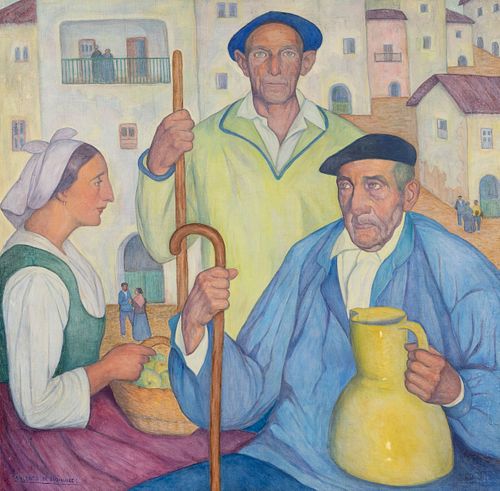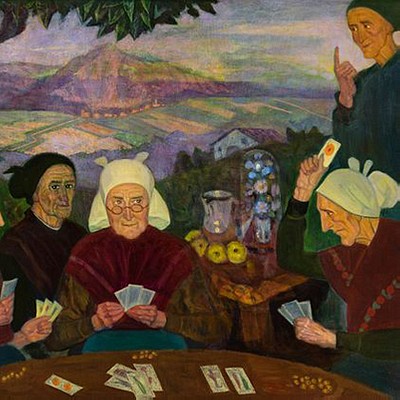VALENTIN DE ZUBIAURRE AGUIRREZÁBAL (Madrid, 1879 - 1963). "Basque types". Oil on canvas.
Lot 88
About Seller
Setdart Auction House
Carrer Aragó 346
Barcelona
Spain
Setdart Subastas was born in 2004 and is currently the first online art auction in Spain with solidity, prestige and reliability guaranteed by our more than 60,000 users. Setdart has a young, dynamic and enterprising team ready to successfully manage the purchase and sale of art works through custom...Read more
Estimate:
EUR€20,000 - EUR€25,000
$21,505.38 - $26,881.72
Absentee vs Live bid
Two ways to bid:
- Leave a max absentee bid and the platform will bid on your behalf up to your maximum bid during the live auction.
- Bid live during the auction and your bids will be submitted real-time to the auctioneer.
Bid Increments
| Price | Bid Increment |
|---|---|
| EUR€0 | EUR€10 |
| EUR€200 | EUR€25 |
| EUR€500 | EUR€50 |
| EUR€1,000 | EUR€100 |
| EUR€3,000 | EUR€200 |
| EUR€5,000 | EUR€500 |
| EUR€10,000 | EUR€1,000 |
| EUR€20,000 | EUR€2,000 |
| EUR€50,000 | EUR€5,000 |
About Auction
By Setdart Auction House
Dec 14, 2021
Set Reminder
2021-12-14 08:00:00
2021-12-14 08:00:00
America/New_York
Bidsquare
Bidsquare : 19th & 20th Century Fine Art
https://www.bidsquare.com/auctions/setdart-auction-house/19th-20th-century-fine-art-7992
Gaudi, Sorolla, Torres Garcia, Maclet, TSUGUHARU FOUJITA, Benjamin Palencia Setdart Auction House sofia@setdart.com
Gaudi, Sorolla, Torres Garcia, Maclet, TSUGUHARU FOUJITA, Benjamin Palencia Setdart Auction House sofia@setdart.com
- Lot Description
VALENTIN DE ZUBIAURRE AGUIRREZÁBAL (Madrid, 1879 - 1963). "Basque types". Oil on canvas. Signed in the lower left corner. With label on the back of the XXemeExpositionBiennaleInternationale des Beaux-Arts, Venice, 1936. Measurements: 101 x 101 cm; 123 x 123 cm (frame). Valentín de Zubiaurre demonstrates in this painting his superb gifts as a portraitist, reflecting with naturalism and closeness to the three main characters, perfectly individualized in their attitudes and features. Zubiaurre, who knew like no one else how to represent the people of his time, especially Basques and Castilians, takes pleasure in the attitudes of the figures, with serious and measured gestures. The young girl, dressed in popular Basque clothing, is presented in strict profile, holding a basket of fruit in her right hand. Her gaze is directed to the old man in front of her, whose reflective face alludes to hard work and life in the countryside. In his right hand he holds a walking stick, revealing his advanced age, while in his left he holds a jar. Like him, the villager behind him, with an imperturbable gesture, wears popular clothes and a txapela. Special mention should be made of this last character, who looks directly at the viewer, an aspect that departs from what is usual in contemporary Spanish genre painting, where the characters usually ignore the painter's presence (as, in this composition, the other two villagers do). Behind this monumental group portrait, we see a group of houses of the village unfold. The white walls and gabled roofs tell us that we are in a small village in the Basque Country, full of life according to the locals who invade its streets. The son of the musical composer of the same name, Valentín de Zubiaurre was born deaf and dumb, as was his younger brother Ramón, also a painter. He began his training with the painter Daniel Perea, also deaf and mute, before entering the San Fernando Royal Academy of Fine Arts in 1894. There he was a disciple of Carlos de Haes, Muñoz Degrain, Ferrant and Moreno Carbonero, and at the same time he completed his solid training by visiting the Prado Museum. In 1898 the two Zubiaurre brothers embarked on a study trip that would take them to France, Italy and the Netherlands. On their return to Spain they obtained a scholarship from the Diputación de Vizcaya in 1902, which allowed them to settle in Paris. There they attended classes at the Académie Julian, became acquainted with the modern trends that were then developing in the French capital and became interested in Impressionism. However, the Zubiaurre brothers were not permeable to its influence, mainly due to the weight of their academic training and their admiration for the Flemish and Italian primitives as well as for contemporary Spanish painters such as Dario de Regoyos and, especially, Ignacio Zuloaga. Valentín de Zubiaurre regularly sent his works to the National Exhibitions of Fine Arts, being awarded on several occasions; in 1908 he obtained the second medal, and in 1917 he was awarded the first medal. He was also distinguished with awards from foreign institutions, and won prizes in outstanding international competitions held in the first decade of the 20th century, among them those of Munich, Buenos Aires, Brussels, San Francisco, San Diego and the University of Panama. From the 1920s until the Civil War, the Zubiaurre brothers experienced their period of greatest success and recognition, both in Spain and internationally. After the war Valentín de Zubiaurre resumed his career in Spain, and his recognition became official with his appointment as a full member of the Royal Academy of Fine Arts of San Fernando in 1945, culminating with the medal of honor awarded to him at the National Exhibition of Fine Arts in 1957, six years before his death. He is currently represented in the Fine Arts Museums of Chicago, Buenos Aires, Paris, Luxembourg, Munich, Berlin, Tokyo, Pittsburg and San Diego, as well as in the main art galleries of the Basque Country, the Castagnino Museum in Argentina, the Reina Sofía National Art Center, the BBVA collection and the Museum of Modern Art in Rome, among others, both public and private.
- Shipping Info
-
In-house shipping available. Please inquire at admin@setdart.com.
-
- Buyer's Premium



 EUR
EUR CAD
CAD AUD
AUD GBP
GBP MXN
MXN HKD
HKD CNY
CNY MYR
MYR SEK
SEK SGD
SGD CHF
CHF THB
THB
















